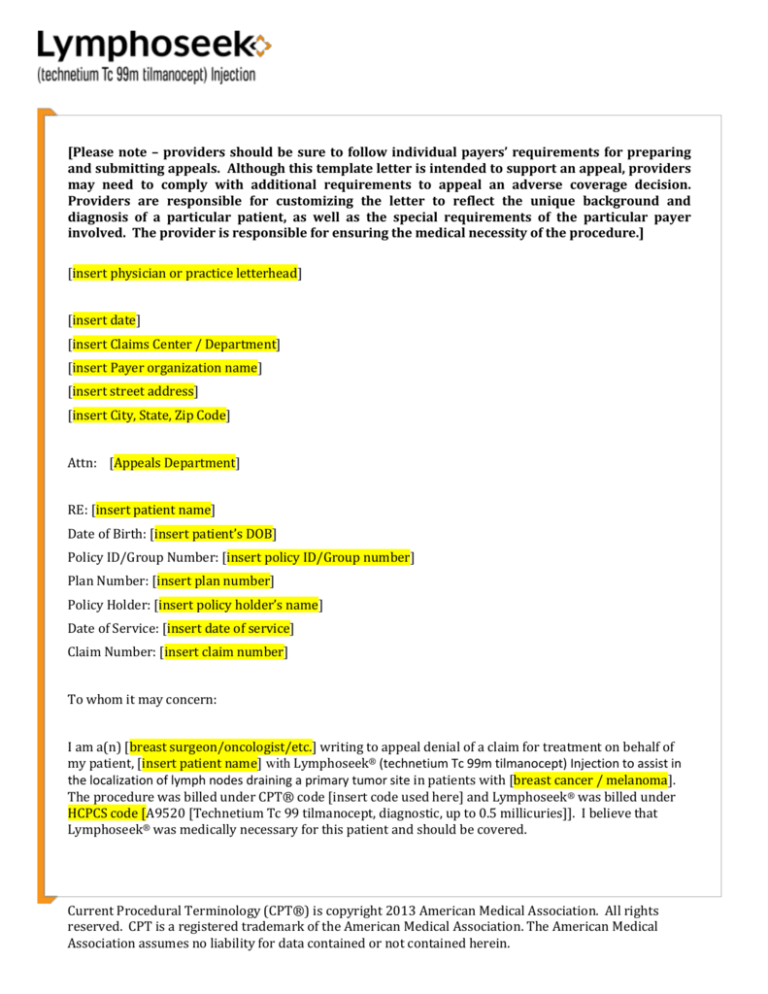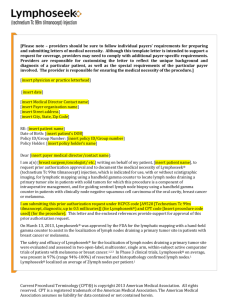
[Please note – providers should be sure to follow individual payers’ requirements for preparing
and submitting appeals. Although this template letter is intended to support an appeal, providers
may need to comply with additional requirements to appeal an adverse coverage decision.
Providers are responsible for customizing the letter to reflect the unique background and
diagnosis of a particular patient, as well as the special requirements of the particular payer
involved. The provider is responsible for ensuring the medical necessity of the procedure.]
[insert physician or practice letterhead]
[insert date]
[insert Claims Center / Department]
[insert Payer organization name]
[insert street address]
[insert City, State, Zip Code]
Attn: [Appeals Department]
RE: [insert patient name]
Date of Birth: [insert patient’s DOB]
Policy ID/Group Number: [insert policy ID/Group number]
Plan Number: [insert plan number]
Policy Holder: [insert policy holder’s name]
Date of Service: [insert date of service]
Claim Number: [insert claim number]
To whom it may concern:
I am a(n) [breast surgeon/oncologist/etc.] writing to appeal denial of a claim for treatment on behalf of
my patient, [insert patient name] with Lymphoseek® (technetium Tc 99m tilmanocept) Injection to assist in
the localization of lymph nodes draining a primary tumor site in patients with [breast cancer / melanoma].
The procedure was billed under CPT® code [insert code used here] and Lymphoseek® was billed under
HCPCS code [A9520 [Technetium Tc 99 tilmanocept, diagnostic, up to 0.5 millicuries]]. I believe that
Lymphoseek® was medically necessary for this patient and should be covered.
Current Procedural Terminology (CPT®) is copyright 2013 American Medical Association. All rights
reserved. CPT is a registered trademark of the American Medical Association. The American Medical
Association assumes no liability for data contained or not contained herein.
Intraoperative Lymphatic Mapping (ILM) is a procedure to assist the [breast surgeon / oncologist] in the
diagnostic evaluation of the patient’s cancer. Identification of first draining lymph nodes is a strong
predictor of lymph node status and long-term patient outcome in [breast cancer / melanoma].1,2 [In
breast cancer, ILM and sentinel node biopsy is recommended for patients with early stage breast cancer
(i.e., T1 or T2 tumors </=50 mm in greatest diameter, and in select cases of ductal carcinoma in situ.3,4 In
melanoma, ILM and sentinel lymph node biopsy is recommended for patients with intermediatethickness melanoma and or patients with thick melanomas for staging purposes and to facilitate regional
disease control.5]
On March 13, 2013, Lymphoseek® was approved by the FDA for lymphatic mapping with a hand-held
gamma counter to assist in the localization of lymph nodes draining a primary tumor site in patients with
breast cancer or melanoma.
The safety and efficacy of Lymphoseek® for the localization of lymph nodes draining a primary tumor site
were evaluated in two pivotal Phase 3 open-label, multicenter, single-arm, within-subject, activecomparator trials of patients with either melanoma or breast cancer.6, 7, 8 In Phase 3 clinical trials,
Lymphoseek® on average, was present in 97% (range 94%-100%) of resected and histopathology
confirmed lymph nodes.6 Lymphoseek® localized an average of 2.4 lymph nodes per patient.6
In clinical trials, no serious adverse reactions were reported during clinical trials with Lymphoseek®. The
most common adverse reactions in clinical trials (n = 542 patients) were:6
Injection site irritation: 0.6%; n = 3 of 542
Injection site pain: 0.2%; n = 1 of 542
Other adverse reactions were uncommon, and of mild severity and short duration
Diagnostic efficacy was determined by the number of histology-confirmed lymph nodes detected by
Lymphoseek®. Lymphoseek® (50 mcg; 0.5 mCi) was injected into patients at least 15 minutes prior to the
scheduled surgery, and blue dye was injected shortly prior to initiation of the surgery. Intraoperative
lymphatic mapping was performed using a hand-held gamma detection probe followed by excision of
lymph nodes identified by Lymphoseek®, blue dye, or the surgeon’s visual and palpation examination. The
resected lymph nodes were sent for histopathology evaluation.6
In Study One, of 179 patients who received Lymphoseek®, 94 (53%) had known or suspected breast
cancer and 85 (48%) had known or suspected melanoma. The median age was 59 years (range 20 to 90
years) and most (72%) were women.6
In Study Two, of 153 patients who received Lymphoseek, 77 (50%) had known or suspected breast
cancer and 76 (50%) had known or suspected melanoma. The median age was 61 years (range 26 to 88
years) and most (68%) were women.6
For additional information, please visit www.lymphoseek.com or call Navidea Medical Drug Information
at 1-800-476-5270.
Current Procedural Terminology (CPT®) is copyright 2013 American Medical Association. All rights
reserved. CPT is a registered trademark of the American Medical Association. The American Medical
Association assumes no liability for data contained or not contained herein.
[Mr./Ms./Mrs.] [insert patient’s last name] is a [insert age] year old [female/male] who has [breast
cancer/malignant melanoma] (ICD-9-CM [insert ICD-9 codes]). [Mr./Ms./Mrs.] [insert patient’s last
name] presented to me on [insert date] with [details such as physical exam results and clinical
impressions]. [If other localization products were used or considered prior to Lymphoseek®, would add:
Other therapies [tried/considered] as part of the localization of [Mr./Mrs./Ms.] [insert patient’s last
name]’s lymph nodes included [describe other products]. However, [provide rationale for using
Lymphoseek® as compared to comparator products, or why it was used following a comparator product.]
I treated [Mr./Ms./Mrs.] [insert patient’s last name] with Lymphoseek® (technetium Tc 99m tilmanocept)
Injection on [insert date] to assist in the localization of lymph nodes draining a primary tumor site in
patients with breast cancer or melanoma. The Lymphoseek® dose required for this patient was [insert
dose] µg tilmanocept and a technetium Tc 99m dose of [insert dose].
This patient’s response to Lymphoseek® was [describe results]. Based on this outcome, I [plan to
treat/treated] [Mr./Mrs./Ms.] [insert patient’s last name] with [indicate how the results of the test impact
patient management – i.e., the planned course of treatment and duration]. Follow-up is expected to
involve [include expected additional evaluations and treatments].
Lymphoseek® was medically necessary in the localization of lymph nodes draining the primary tumor site
of [Mr./Mrs./Ms.] [insert patient’s last name]’s [breast cancer/malignant melanoma]. Thank you for your
consideration of this matter. If you have any questions or require additional information, please contact
me at [insert physician’s contact information].
Respectfully submitted,
[Physician Signature]
[Physician’s full name]
[Address]
[Telephone number]
Current Procedural Terminology (CPT®) is copyright 2013 American Medical Association. All rights
reserved. CPT is a registered trademark of the American Medical Association. The American Medical
Association assumes no liability for data contained or not contained herein.
Indication
Lymphoseek (technetium Tc 99m tilmanocept) Injection is indicated for lymphatic mapping with a handheld gamma counter to assist in the localization of lymph nodes draining a primary tumor site in patients
with breast cancer or melanoma.
Important Safety Information
In clinical trials with Lymphoseek, no serious hypersensitivity reactions were reported, however
Lymphoseek may pose a risk of such reactions due to its chemical similarity to dextran. Serious
hypersensitivity reactions have been associated with dextran and modified forms of dextran (such as iron
dextran drugs).
Prior to the administration of Lymphoseek, patients should be asked about previous hypersensitivity
reactions to drugs, in particular dextran and modified forms of dextran. Resuscitation equipment and
trained personnel should be available at the time of Lymphoseek administration, and patients observed
for signs or symptoms of hypersensitivity following injection.
The most common adverse reactions are injection site irritation and/or pain (<1%).
References
1.
2.
3.
4.
5.
6.
Schulze T, Mucke J, Markwardt J, Schlag PM, Bembenek A. Long-term morbidity of patients with
early breast cancer after sentinel lymph node biopsy compared to axillary lymph node dissection.
J Surg Oncol. 2006;93(2):109-119.
Veronesi U, Galimberti V, Zurrida S, et al. Sentinel lymph node biopsy is an indicator for axillary
dissection in early breast cancer. Eur J Cancer. 2001;37(4):454-458.
Lyman GH, Giuliano AE, Sommerfeld MR, et al. American Society of Clinical Oncology Guideline
Recommendations for Sentinel Lymph Node Biopsy in Early-Stage Breast Cancer. J Clin Oncol.
2005;23(30):7703-7720.
NCCN Clinical Practice Guideline: Breast Cancer. Available at:
http://www.nccn.org/professionals/physician_gls/pdf/breast.pdf Accessed August 13, 2012.
Wong SL, Balch CM, Hurley P, et al. Sentinel Node Biopsy for Melanoma: American Society of
Clinical Oncology and Society of Surgical Oncology Joint Clinical Practice Guideline. Ann Surg
Oncol, epub July 6, 2012.
LYMPHOSEEK Injection Package Insert. Dublin, OH: Navidea Biopharmaceuticals, Inc., Dublin OH;
February 2013.
7. Sondak VK, King DW, Zager J, et al Combined analysis of Phase III trials evaluating
[99mTc]Tilmanocept and vital blue dye for identification of sentinel lymph nodes in clinically
node-negative cutaneous melanoma. Ann Surg Oncol 2013;20:680-8.
8. Wallace AM, Han LK, Povoski SP, et al. Comparative evaluation of [99mTc]Tilmanocept for
sentinel node mapping in breast cancer patients: results of two phase 3 trials. Ann Surg Oncol;
2013;20:2590-9.
Current Procedural Terminology (CPT®) is copyright 2013 American Medical Association. All rights
reserved. CPT is a registered trademark of the American Medical Association. The American Medical
Association assumes no liability for data contained or not contained herein.








